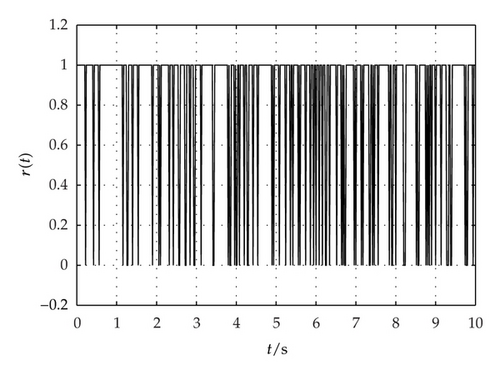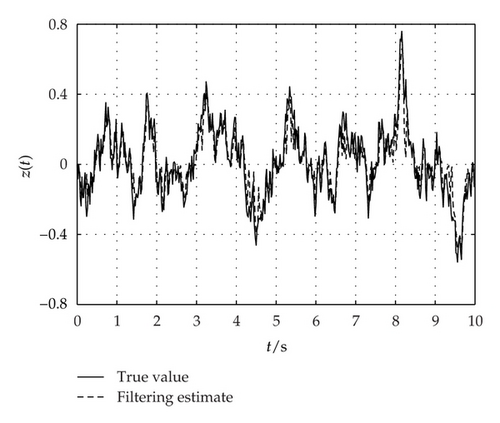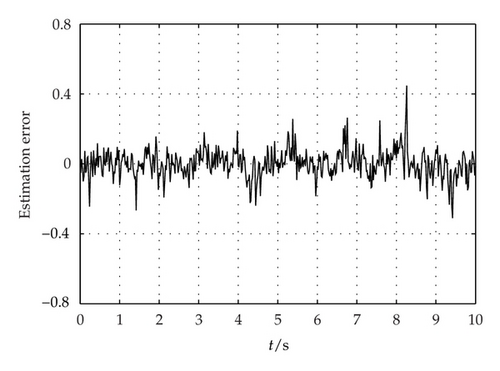Finite-Time H∞ Filtering for Linear Continuous Time-Varying Systems with Uncertain Observations
Abstract
This paper is concerned with the finite-time H∞ filtering problem for linear continuous time-varying systems with uncertain observations and ℒ2-norm bounded noise. The design of finite-time H∞ filter is equivalent to the problem that a certain indefinite quadratic form has a minimum and the filter is such that the minimum is positive. The quadratic form is related to a Krein state-space model according to the Krein space linear estimation theory. By using the projection theory in Krein space, the finite-time H∞ filtering problem is solved. A numerical example is given to illustrate the performance of the H∞ filter.
1. Introduction
Most of the literatures on estimation problem always assume the observations contain the signal to be estimated [1–8]. In [5], the linear matrix inequality technique was applied to solve the finite-time H∞ filtering problem of singular Markovian jump systems. In [6], new stability and robust stability results for 2D discrete stochastic systems were proposed based on weaker conservative assumptions. In [7], an observer was incorporated to the vaccination control rule for an SEIR propagation disease model. In [8], two linear observer prototypes for a class of linear hybrid systems were proposed based on the prediction error. However, in practice, the observation may contain the signal in a random manner, that is, the observation consists of noise alone in a nonzero probability, and it is commonly called uncertain observations or missing measurements [9, 10]. In this paper, the finite-time H∞ filtering problem is investigated for linear continuous time-varying systems with uncertain observations and ℒ2-norm bounded noises.
The H2-based optimal filtering has been well studied for linear systems with uncertain observations [9–13]. In [9], the recursive least-squares estimator was proposed for linear discrete-time systems with uncertain observations. The robust optimal filter for discrete time-varying systems with missing measurements and norm-bounded parameter uncertainties was designed by optimizing the upper bound of the state estimation error variance in [10]. Using the covariance information, the recursive least-squares filtering and fixed-point smoothing algorithms for linear continuous-time systems with uncertain observations were proposed in [11]. Linear and nonlinear one-step prediction algorithms for discrete-time systems with uncertain observations were presented from a covariance assignment viewpoint in [12]. The statistical convergence properties of the estimation error covariance were studied, and the existence of a critical value for the arrival rate of the observations was shown in [13]. In recent years, due to the fact that the H∞-based estimation approach does not require the information on statistics of input noise, it has received more and more attention for linear systems with uncertain observations [14–16]. Using Lyapunov function approach, the H∞ filtering algorithms in terms of linear matrix inequalities were proposed for systems with missing measurements in [14–16]. To authors’ best knowledge, research on finite-time H∞ filtering for linear continuous time-varying systems with uncertain observations has not been fully investigated and remains to be challenging, which motivates the present study.
Although the Krein space linear estimation theory [1, 3] has been applied to fault detection and nonlinear estimation [17, 18], no results have been developed for systems with uncertain observations, which will be an interesting research topic in the future. In this paper, the problem of finite-time H∞ filtering will be investigated for linear continuous time-varying systems with uncertain observations and ℒ2-norm bounded input noise. Based on the knowledge of Krein space linear estimation theory [1, 3], a new approach in Krein space will be developed to handle the H∞ filtering problem for linear continuous time-varying systems with uncertain observations. It will be shown that the H∞ filtering problem for linear continuous time-varying systems with uncertain observations is partially equivalent to an H2 filtering problem for a certain Krein space state-space model. Through employing projection theory, both the existence condition and a solution of the H∞ filtering can be obtained in terms of a differential Riccati equation. The major contribution of this paper can be summarized as follows: (i) it shows that the H∞ filtering problem for systems with uncertain observations can be converted into an H2 optimal estimation problem subject to a fictitious Krein space stochastic systems; (ii) it develops a Kalman-like robust estimator for linear continuous time-varying systems with uncertain observations.
Notation. Elements in a Krein space will be denoted by boldface letters, and elements in the Euclidean space of complex numbers will be denoted by normal letters. The superscripts “−1” and “*” stand for the inverse and complex conjugation of a matrix, respectively. δ(t − τ) = 0 for t ≠ τ and δ(t − τ) = 1 for t = τ. ℝn denotes the n-dimensional Euclidean space. I is the identity matrix with appropriate dimensions. For a real matrix, P > 0 (resp., P < 0) means that P is symmetric and positive (resp., negative) definite. 〈·, ·〉 denotes the inner product in Krein space. diag {⋯} denotes a block-diagonal matrix. θ(t) ∈ ℒ2[0, T] means . ℒ{⋯} denotes the linear space spanned by sequence {⋯}. An abstract vector space {𝒦, 〈·, ·〉} that satisfies the following requirements is called a Krein space [1].
- (i)
𝒦 is a linear space over 𝒞, the field of complex numbers.
- (ii)
There exists a bilinear form 〈·, ·〉∈𝒞 on 𝒦 such that
- (a)
〈y, x〉 = 〈x, y〉 *,
- (b)
〈ax + by, z〉 = a〈x, z〉+b〈y, z〉,
-
for any x, y, z ∈ 𝒦, a, b ∈ 𝒞, and where * denotes complex conjugation.
- (iii)
The vector space 𝒦 admits a direct orthogonal sum decomposition
() -
such that {𝒦+, 〈·, ·〉} and {𝒦−, −〈·, ·〉} are Hilbert spaces, and
() -
for any x ∈ 𝒦+ and y ∈ K−.
2. System Model and Problem Formulation
- (I)
Jℱ has a minimum with respect to ;
- (II)
can be chosen such that the value of Jℱ at its minimum is positive.
3. Main Results
In this section, through introducing a fictitious Krein space-state space model, we construct a partially equivalent Krein space projection problem. By using innovation analysis approach, we derive the finite-time H∞ filter and its existence condition.
3.1. Construct a Partially Equivalent Krein Space Problem
According to [1] and [3], we have the following results.
Lemma 3.1. Consider system (2.1), given a scalar γ > 0 and a matrix P0 > 0, then Jℱ in (2.3) has the minimum over {x0, w(t)|0≤t≤T} if and only if the innovation exists for 0 ≤ t ≤ T, where
Remark 3.2 3.2. By analyzing the indefinite quadratic form Jℱ in (3.4) and using the Krein space linear estimation theory [1], it has been shown that the H∞ filtering problem for linear systems with uncertain observations is equivalent to the H2 estimation problem with respect to a Krein space stochastic system, which is new as far as we know. In this case, Krein space projection method can be applied to derive an H∞ estimator for linear systems with uncertain observations, which is more simple and intuitive than previous versions.
3.2. Solution of the Finite-Time H∞ Filtering Problem
By applying the standard Kalman filter formula to system (3.6), we have the following lemma.
Lemma 3.3. Consider the Krein space stochastic system (3.6), the prediction is calculated by
Now we are in the position to present the main results of this subsection.
Theorem 3.4 3.4. Consider system (2.1), given a scalar γ > 0 and a matrix P0 > 0, and suppose P(t) is the bounded positive definite solution to Riccati differential equation (3.14). Then, one possible level-γ finite-time H∞ filter that achieves (2.3) is given by
Proof. It follows from Lemma 3.3 that if P(t) is a bounded positive definite solution to Riccati differential equation (3.14), then the projection exists. According to Lemma 3.1, it is obvious that the H∞ filter that achieves (2.3) exists. If this is the case, the minimum value of Jℱ is given by (3.11). In order to achieve min Jℱ > 0, one natural choice is to set
On the other hand, from (3.12) and (3.15), It is easy to verify that (3.16) holds.
Remark 3.5. Let
- (i)
(C(t), A(t)) is detectable,
- (ii)
w(t), v(t) ∈ ℒ2[0, T].
4. A Numerical Example



5. Conclusions
In this paper, we have proposed a new finite-time H∞ filtering technique for linear continuous time-varying systems with uncertain observations. By introducing a Krein state-space model, it is shown that the H∞ filtering problem can be partially equivalent to a Krein space H2 filtering problem. A sufficient condition for the existence of the finite-time H∞ filter is given, and the filter is derived in terms of a differential Riccati equation.
Future research work will extend the proposed method to investigate the H∞ multistep prediction and fixed-lag smoothing problem for linear continuous time-varying systems with uncertain observations.
Acknowledgments
The authors sincerely thank the anonymous reviewers for providing valuable comments and useful suggestions aimed at improving the quality of this paper. The authors also thank the editor for the efficient and professional processing of their paper. This work is supported by the National Natural Science Foundation of China (60774004, 61034007, and 60874016) and the Independent Innovation Foundation of Shandong University, China (2010JC003).




